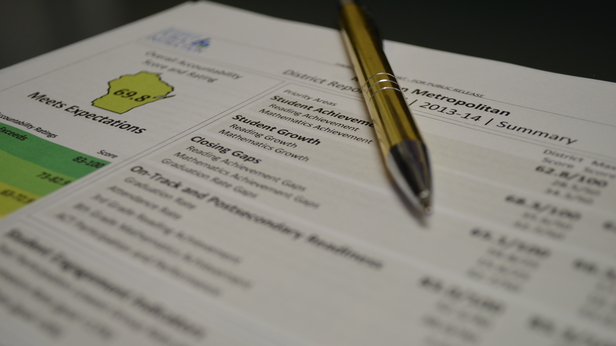
MPS Officials say one thing, the data says another.
November 29, 2016
By Ola Lisowski
MacIver Institute Research Associate
After a busy fall of education news, Wisconsin’s public school report cards are out. The verdict, as usual, depends on who you ask. Such releases tend to be a remarkable display of doublespeak.
The major takeaway – that Milwaukee Public Schools (MPS) fell off the list of failing school districts – wasn’t even news. Nearly everyone from the State Superintendent to MPS officials not-so-discreetly hinted at the change before it happened, which the MacIver Institute previously covered. In their respective press releases, MPS and the Department of Public Instruction (DPI) both celebrate the news.
The MPS release writes that:
As a district, MPS no longer is in the Fails to Meet Expectations category, but the Meets Few Expectations category. MPS’ local STAR assessment data shows growth in student achievement and signals that the district is closing the student achievement gap:
- Literacy is improving across all grade levels.
- The number of students on target for proficiency in reading improved last year by two percent.
- Early reading schools improved significantly, with 51 percent of all K5 and first graders on target at the end of the school year, compared to only 43 percent on target at the beginning of the school year.
- ACT statewide data showed students meeting readiness increased 1-2 percent in English, reading, math and science. The data also showed an increase in students meeting readiness in all four tested areas.
In a similar manner, DPI’s release celebrates the fact that most schools and districts met expectations on the new report cards. We did it! That is, if you believe the talking heads or the mainstream media headlines.
The releases don’t mention last month’s news that nearly six out of ten Wisconsin students are performing below grade level. Though if you’re waiting for two of the most entrenched political forces in Wisconsin education – DPI and MPS – to serve up self-criticism, don’t hold your breath.
While MPS dropped off the failing list to great fanfare and publicity, pushing past the headlines you find a much different picture. Despite no longer being categorized as a failing district, there are still 25,000 students who attend schools within the district that are failing. I wonder if the 25,000 kids trapped in bad schools celebrated the wonderful “we are no longer failing” news with Dr. Driver? Just 19.5 percent of MPS students are proficient in English and 14.9 percent in math. Only 7.5 percent of black students at MPS are proficient in math. How in the world can the district rise from the failing list when only one in five students is proficient in English or math? Do MPS parents, or any parent for that matter, think this makes sense? When students graduate MPS high schools and go onto the University of Wisconsin System, many must take remedial coursework for zero credits and full tuition.
It seems that in 2016, the gap between the official word and the reality on the ground is getting further and further apart.
Of course, it’s not just a Milwaukee problem. While just five districts out of 424 – Racine, Cassville, Cambria-Friesland, and Menominee Indian – are marked as failing, 52,201 students attend schools that are failing. And that’s just the tip of the iceberg.
Green Bay Area Public School District, the fourth largest in the state by student enrollment, scored 61 out of 100 points and was dubbed as meeting few expectations. That “few” was likely more of a “phew” for school officials when they realized they wouldn’t have to deal with the official failing label. And yet, the English proficiency rate at Green Bay is 32 percent. The math proficiency rate is 29 percent. It’s a stunning display of disconnect.
The University of Wisconsin Report on Remedial Education serves as a strong recent datapoint that can inform the public on how well schools are actually performing. The report lists high schools which sent more than six graduates into the UW System who needed remedial education – that is, required math and English catchup courses, taken at full tuition and for zero credits.
Auburndale High School in rural Wood County sent one-third of its graduating class into the UW System needing math remediation. On the report card, that school meets expectations, having earned 67.6 of 100 points. At Brown Deer High School, which earned a 77.7 of 100, exceeding expectations, 43 percent of the graduating class needed math remediation and 18 percent required English remediation. Horicon High School met expectations and sent fully half of its graduation class to UW needing math remediation. Johnson Creek exceeded expectations while 80 percent of its 2015 class required math remediation.
Back in Milwaukee, the School of Languages met expectations with a 20.4 percent math proficiency and 42 percent of graduates needing math remediation. The school is listed as 20th most challenging school in the state by the Washington Post and 25th best school in the state by U.S. News and World Report.
And so, who is the public to trust? I once heard someone say that the plural of anecdotes is not data. Wisconsinites would be wise to heed that advice. Excel spreadsheets are less interesting than compelling quotes from public officials, but when everyone’s saying different things, the only thing you can really trust is the data itself.